Let’s take a look at our partner node setup, which focuses on validating, delegating, and the excellent opportunity to contribute to the Beam blockchain’s growth and security.
You can use our YourCryptoLibrary node (NodeID-nK6qBbpgpSUhhGoUiH5hHH58seKdLVdw) if you are looking for a reliable and trustworthy partner to help secure the network and earn rewards in the process.
Table of Contents
How to Earn and Secure the Beam Blockchain
The Beam Network has introduced an exciting opportunity for users to participate in its growth and security through the Horizon upgrade.
By setting up a Beam Node Validator or delegating tokens to existing validators, users can contribute to the network’s decentralization while earning rewards. This comprehensive guide will walk you through the process of becoming a Beam Node Validator, the requirements, and the potential benefits.
Beam’s Sovereign Blockchain – Beam
What started as an open-source blockchain subnet on Avalanche is now fully independent. This means that this gaming-focused blockchain can operate on its own while remaining chain agnostic. Interested in Beam’s blockchain fundamentals? Learn more about Beam Coin and its privacy-focused features.
What is a Beam Node Validator?
A Beam Node Validator ensures the integrity of the blockchain by verifying transactions and adding new blocks. Think of Beam validators as security guards for a digital vault—they ensure that all activities inside the network are legitimate and secure. Validators also play an essential role in Beam’s treasury distribution system, where 50% of the treasury is allocated to node holders.
Validators:
- Facilitate private, smooth transactions.
- Prevent centralization by maintaining a distributed network.
- Secure the network while earning rewards from transaction fees and treasury allocation.
Since the Horizon upgrade, the Beam Network has its own permissionless, proof-of-stake consensus mechanism. This allows anyone who meets the criteria to validate and secure the network.
Beam Nodes support multiple blockchain protocols including Ethereum, Avalanche, Arbitrum, Base, and Beam itself. Nodes are a means for:
- Lower Latency: As nodes spread across more blockchains, they offer reduced latency in transaction processing.
- Improved Uptime and Security: With security protocols in place, Beam Nodes provide a reliable and secure environment for validating blockchain transactions.
- Access to Multiple Crypto Rewards: Users earn rewards in multiple currencies like $BEAM, $ATH, $ZENT, and $SAGA.
- Exclusive Benefits for Node Holders: A staggering 50% of Beam’s Treasury will benefit node holders.
A beam node is a vital component of the sovereign Beam blockchain that needs nodes to uphold the network’s protocol and maintain its security and uptime.
Beam Node Pricing & Fees
After the initial minting fee was set at $1,250 during the first week post-launch, we can now buy a node at the standard minting fee of $3,750, payable in $BEAM, $ETH, $AVAX and $USDC.
Please note that a 7.5% fee on each sale will be deducted in line with Beam’s deflationary mechanisms by burning $BEAM. Also, any funds used for minting, if not in BEAM, are converted to BEAM by an autonomous smart contract and then burned.
How Much Do Beam Node Validators Earn?
Beam Node Validator earnings are a combination of transaction fees and treasury distributions:
- Treasury Allocation: Validators receive 50% of Beam’s treasury funds.
- Transaction Fees: A portion of fees from every processed transaction is distributed to validators.
Example: Validators experience higher earnings during periods of increased activity, such as when Beam’s ecosystem supports NFT or DeFi projects. Learn how staking directly impacts your earnings in our guide on Beam expanding ecosystem.
Steps to Become a Beam Node Validator (Before Minting)
Becoming a Beam Node Validator is a straightforward process if you’re prepared with the right tools and resources:
- Set Up the Right Hardware and Software
Ensure your system meets the requirements for running the Beam node software. Download and install the node software from the official Beam Node Documentation. - Stake the Required Tokens
Beam requires staking 1 Node Token and 20,000 BEAM tokens, a mechanism designed to enhance decentralization and network security. - Sync and Configure Your Node
Follow Beam’s comprehensive Node Token Mint Instructions to finalize setup and connect your node to the blockchain.
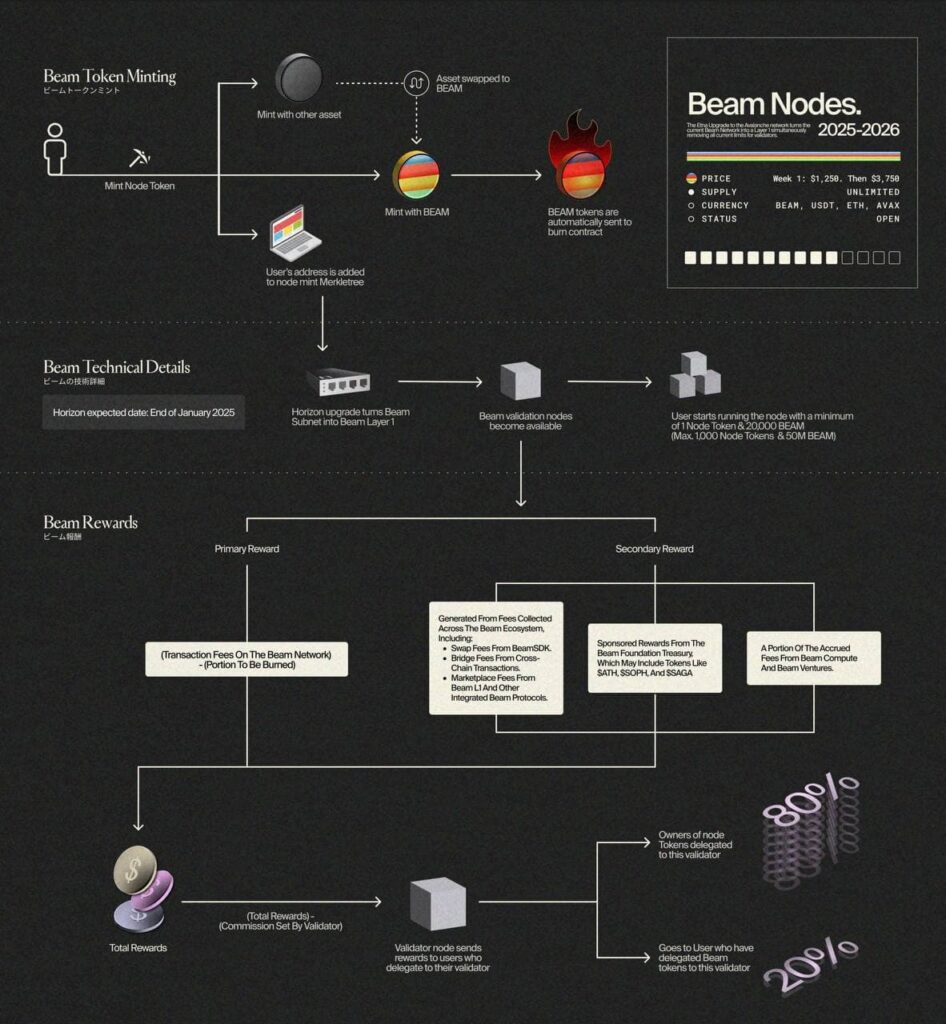
Real-world analogy: Running a Beam Node Validator is like setting up a toll gate on a private road. You invest upfront, but with every car (transaction) passing through, you earn revenue. For direct access to node configuration, visit the Beam Nodes Portal.
Hardware Requirements for Running a Beam Node
Running a Beam Node requires modest hardware specifications:
- CPU: Equivalent to 8 AWS vCPUs
- RAM: 16 GiB of memory
- Storage: At least 1 TiB
- Operating System: Ubuntu 20.04 or MacOS version 12 or newer
- Network: Consistent 5 Mbps upload and download bandwidth
- Configuration: Accept incoming TCP/IP connections on port 9651
Registering Your Beam Validator
Registering as a validator on the Beam Network involves a couple of essential steps. Before you start the installation process, ensure you have:
- Adequate storage space to accommodate blockchain data.
- A stable internet connection.
- Basic familiarity with using command lines.
Step 1: Obtain Your P-Chain Address
First, you’ll need to access your P-Chain address, which is specific to the Avalanche network. This address can only be viewed through the Avalanche Core wallet, available as a Chrome extension.
After setting up and restoring your wallet in Core, navigate to the Avalanche toolchain website at build.avax.network. Ensure you select “Mainnet” as the network to see your P-Chain address displayed at the top.
Step 2: Collect Node Information
The next step involves fetching certain parameters from your node:
- Node ID
- BLS Public Key
- BLS Proof of Possession
To do this in detail you can refer to the official Beam docs on how to configure your Beam node.
Step 3: Complete the Registration Form
With all the necessary information at hand, proceed to the Delegation dashboard. Here, you will fill in the details for your node. If you are setting up multiple nodes as validators, repeat this process for each node. You will also need to specify the amount of BEAM you wish to stake. The minimum requirement is 20,000 BEAM.
Step 4: Submit and Confirm Your Registration
After filling in all the details, click “Finish Registration” and approve the pending transaction. The transaction usually completes within a few minutes. Once confirmed, the Validator Manager contract will add your node to the validator set, and it will appear as active in the validator list.
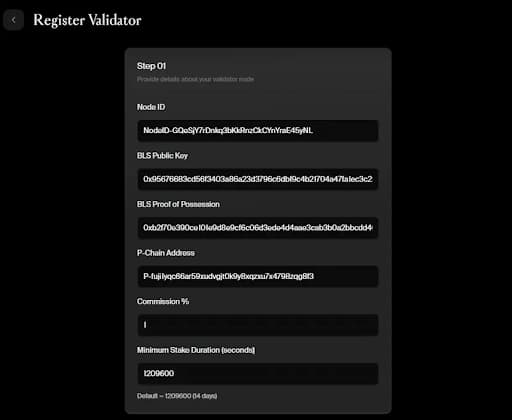
Continuous Fee for Beam Network Validators
Validators must pay a continuous fee of 1.33 AVAX per month to maintain compatibility with the Avalanche network during the transition period. The Beam Foundation plans to provide approximately $750,000 in AVAX to support new validators through an incentive program.
Setting Your Validator Commission Rate
A validator commission is the percentage of rewards that a validator earns from the operations processed on the blockchain. This commission is taken from the rewards that are distributed to delegators who stake their cryptocurrency on your node.
In other words, it’s the fee a node charges for its services. Therefore anyone who sets up a Beam node can decide his commission.
A higher commission means more earnings for the node per transaction, but when set too high, it might drive away potential stakers. Conversely, a lower rate might attract more delegators, but will reduce the nodes earnings.
When setting your commission rate, consider:
- Market average rates charged by other validators
- Costs involved in running your node (hardware, electricity, etc.)
- Your value proposition (additional services, reliability, performance)
What Happens If a Validator Misbehaves? Understanding Slashing Penalties
In cases where validators do not meet uptime requirements or engage in malicious behavior, they and their delegators may face a slashing penalty, reducing their rewards as a consequence for failing to uphold network integrity.
There are two Reasons for when a Node gets Slashed
- Insufficient Uptime: If validators don’t maintain a high level of uptime.
- Malicious Behavior: If other validators identify a validator doing ‘bad’ behaviors such as double signing or any attempts that disrupt the network’s integrity.
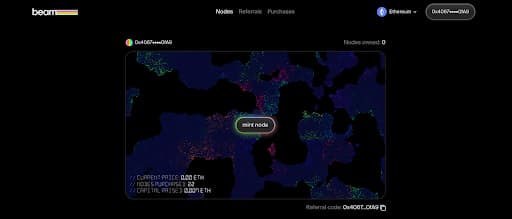
How to Mint a Node Token on the Beam Network
Where Do You Start the Minting Process? Well you can follow our step-by-step guide on how to mint your own Node Token:
- Visit the Official Beam Node page
Navigate to the official Beam node platform at nodes.onbeam.com. Ensure you are on the legitimate website by verifying the URL and using links shared by the Beam Foundation or BuildOnBeam accounts. - Connect Your Wallet
Look for the “Connect Wallet” button in the top right corner and click on it. A popup will appear, displaying a list of compatible wallets such as MetaMask, Phantom, Rabby, and Coinbase Wallet. Select the wallet you want to use and proceed with the connection.- Chain: Choose the Beam Network as the chain.
- Amount: Decide how many Node Tokens you want to mint.Initiate the Minting Process
After connecting your wallet, click the “Mint Node Token” button located in the center of the page to start the minting process. - Referral Code: If you have a referral code, enter it here.
Once you’ve made your selections, click the “Increase Allowance” button to authorize your wallet to interact with the contract. Confirm this action directly in your wallet.
-
Set Your Preferences
In the new popup window, you will need to make the following selections: - Complete the Minting
With your preferences set and permissions granted, click the “Mint” button. You will need to approve and confirm this action in your wallet. Once the transaction is confirmed on the Beam blockchain, the minted Node Token will be visible in your wallet.
Remember, while nodes.onbeam.com is the recommended platform for minting Node Tokens, the open-source nature of the smart contract allows for the development of other interfaces for the same purpose.
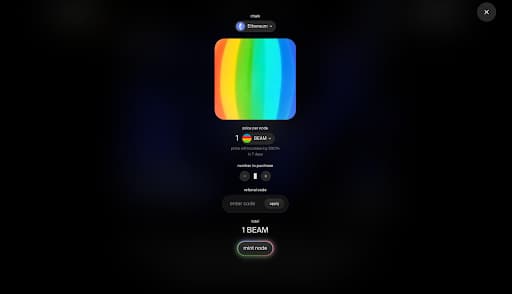
Beam Node Delegation
It will be possible to delegate either BEAM or a Node Token individually, or both, to one or more validators running Beam Nodes. There will be no minimum delegation requirement. Despite not running validator software themselves, delegators can still delegate just 1 Node Token or even 1 BEAM token.
Delegate to YourCryptoLibrary and enjoy a way to earn rewards while supporting the Beam blockchain.
👉 Delegate now to NodeID: nK6qBbpgpSUhhGoUiH5hHH58seKdLVdw“
Delegators should note that validators who run the Beam Nodes can set a commission fee that they take from all earned rewards. This fee is adjustable by each validator.
Similar to the primary rewards, these secondary rewards will flow autonomously to the validators and delegators. 80% of the secondary rewards will go to validators and delegators staking Node Tokens (based on their respective portion of staked Node Tokens). 20% of the secondary rewards will go to validators and delegators staking BEAM (based on their respective portion of staked BEAM).
Furthermore, to maintain proper decentralization of the Beam Network and prevent the rise of centralized and powerful validator sets, there will be a maximum delegation limit of 50 million BEAM and 1,000 Node Tokens per Beam Node. Also, withdrawing a delegated stake will trigger a 21-day waiting period.
For more detailed instructions and the latest updates, visit the official Beam Node Token Mint Instructions.
How to Stake BEAM?
- Navigate to the Delegation Dashboard: Access the list of active validators.
- Select a Validator: Use filters to find a validator that aligns with your investment goals.
- Stake Your BEAM: Commit your tokens to the chosen validator and monitor their performance to mitigate risks.
Beam Node Discount via YourCryptoLibrary
Through our YourCryptoLibrary referral link, you get a 5% discount on Beam Nodes! Note though, that the ref code only works for the first purchase of one or more nodes per wallet. So, if you decide on buying more nodes later, do it from another wallet with the ref link again.
Node-as-a-Service (NaaS) Providers
If you want to participate in the Beam Network without operating a node yourself, you can use a Node-as-a-Service (NaaS) provider. These providers manage the technical aspects of running a node while you maintain control over your staked funds. Some trusted NaaS providers include:
Node-as-a-Service, or NaaS, is a service model where you can engage a third-party provider to manage the operations of a blockchain validator node on your behalf. This arrangement is particularly appealing if you lack the technical expertise or resources to run a node independently.
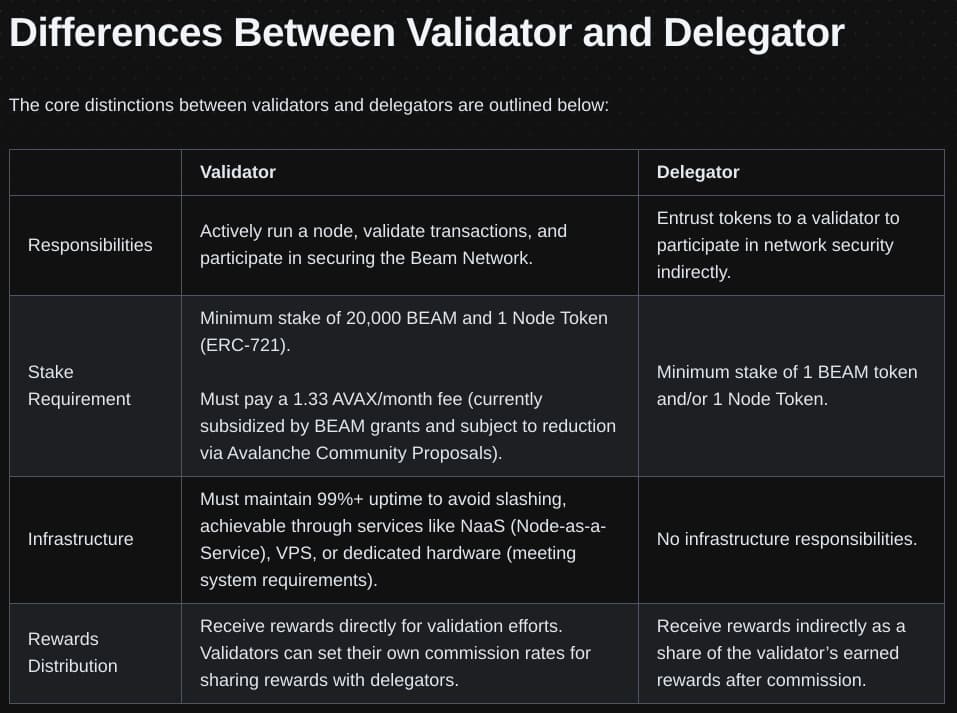
Beam Validators vs. Delegators vs. Node-as-a-Service: What’s the Difference?
Participation in the Beam Network can be approached in three different ways:
Validators, delegators, and Node-as-a-Service (NaaS) providers all play crucial roles in the Beam Network, each with their own level of control, responsibility, and reward potential.
Validators
Validators are the most active participants in the network. They run their own Beam Nodes, which requires meeting technical requirements listed above.
Validators are responsible for validating transactions and maintaining the network’s security, ensuring that the Beam blockchain operates smoothly. In return for their efforts, validators earn rewards directly from transaction fees paid in BEAM tokens and additional rewards from other protocols operating on the Beam Network.
For example, a validator might earn 100 BEAM tokens per day from transaction fees and an additional 50 BEAM tokens per day from rewards related to the BeamSwap protocol.
Delegators – Stakers Beam
On the other hand, delegators are passive participants who support the network by staking their BEAM tokens or Node Tokens with validators.
Delegators do not need to concern themselves with the technical aspects of running a node, as they rely on the validators they stake with to handle these responsibilities. Instead, delegators focus on choosing reliable and effective validators to stake their tokens with. In return, delegators earn a share of the rewards earned by the validators they support.
For instance, if a delegator stakes 1000 BEAM tokens with a validator who earns 100 BEAM tokens per day, the delegator might earn a portion of those rewards based on their stake, such as 5 BEAM tokens per day.
Node-as-a-Service (NaaS) – Stakers Node Tokens
Node-as-a-Service (NaaS) providers offer a unique solution for those who want to participate as validators but lack the technical expertise or resources to run a node independently.
As said before, you can delegate your Beam node token to one of the NaaS providers that manage the technical aspects of running a validator node on behalf of you. All while the client maintain control over their staked funds.
NaaS providers may charge fees or take a share of the rewards as compensation for their services.
For example, a user might engage a NaaS provider to run a validator node on their behalf, staking 10,000 BEAM tokens. The validator node earns 200 BEAM tokens per day, of which the NaaS provider takes a 10% fee, leaving the user with 180 BEAM tokens per day in rewards.

Understanding Beam Rewards
Primary Rewards
The primary rewards on the Beam Network consist solely of the transaction fees, also known as gas fees, collected from the transactions processed on the network. These fees are paid out in BEAM, the native cryptocurrency of the Beam Network.
The distribution of primary rewards is calculated based on a formula that takes into account the total number of active validators, the amount of BEAM staked by each validator and delegator, as well as the overall transaction volume on the network.
Secondary Rewards
In addition to the primary rewards, the Beam Network also offers secondary rewards. These secondary rewards provide additional compensation. The secondary rewards consist of two main components: protocol fees and validator incentive grants.
The protocol fees are generated from various operations within the Beam ecosystem, such as BeamSwap and Sphere, while the validator incentive grants are seasonal payments provided by the Beam Foundation. The distribution of secondary rewards is automated, with 80% going to those staking Node Tokens and 20% going to those staking BEAM tokens.
Claiming Beam Rewards
As of now, rewards cannot be claimed directly through the Delegation dashboard. However, an update is expected soon that will enable this feature.
Once the update is live, you will be able to sign in to the Delegation dashboard using the wallet associated with your delegations or validator node. Here’s how you can expect the process to work:
- Access the Rewards Page: Navigate to the rewards sub-page from the delegations page.
- View Pending Rewards: You’ll see a list of your pending rewards, each of which can be claimed individually.
- Claim Rewards: Click on the reward you wish to claim, and approve the on-chain transaction to receive your rewards.
Why Join the Beam Validator Community?
Beam’s vibrant community supports its validators by providing tools, resources, and regular updates:
- Collaborative Development: Validators benefit from Beam’s open-source tools such as Beam Documentation.
- Regular Updates: Stay informed with news from Beam’s Twitter channel and the latest posts on Medium.
- Hands-On Resources: The Beam Nodes Portal offers direct access to essential validator tools.
Conclusion
Becoming a Beam Node Validator is an excellent opportunity to support the Beam blockchain privacy while earning rewards. Validators are integral to Beam’s network, contributing to its security, decentralization, and overall success. With accessible staking requirements and robust community support, Beam makes validator participation both meaningful and rewarding.
Ready to take the next step? Explore the Beam Node Documentation or connect with the Beam community on Twitter and Medium.
